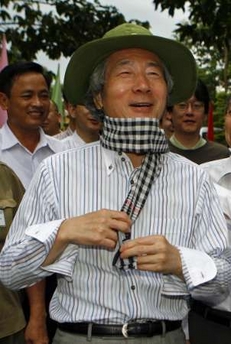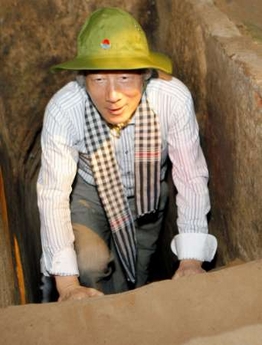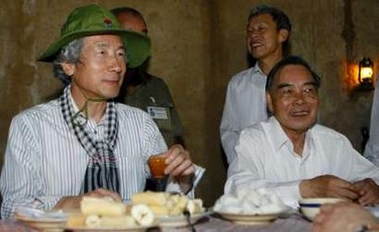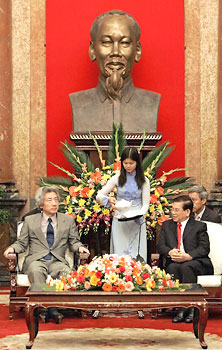Just two weeks ago I posted a link to an article about a Taiwanese “collector” of rare Chinese family names. While his activity may seem to be a mere eccentric hobby, documenting these names and their lineage does have important historical significance, as seen in recent moves by the Chinese government. According to a NYT article from April 20, China has been phasing in an electronic ID card system which does not support many of the exotic antique characters used in rare family names, and their solution has been to ask people affected to change their names.
One of the main examples given in the article is the character [ed: oops, actually the character they reference was too obscure for me to enter using either the Japanese or Chinese IME. I confused it with the still-rare but far more common “驫”. 驫 (骉 simplified, as it would be written in the PRC), pronounced “Cheng” according to the article, but “Biao” according to the dictionary. Apparently the software used for the Chinese ID system does not support this character, despite the fact that I had no problem drawing it on the IME pad in Windows Vista using my house, and it can even be found in the Japanese language Wiktionary.
(Before I go on, I want to note briefly that the word 漢字, meaning “Chinese character” is used in Chinese, Korean and Japanese, respectively pronounced hanzi, hanja, and kanji. When using one of these three words I am specifically referring to the use of Chinese characters in that country/language.)
According to the article, the computer system currently in use by the government supports 32,252 hanzi, out of well over 50,000 found in the most comprehensive classical dictionaries. The government is currently working on a restricted list of characters approves for use in modern Chinese writing, which they estimate will exceed 8000 characters-a significant drop from even the current de-facto list of 32,252.
While these sorts of legal restrictions on one’s very name name may sound stereotypically totalitarian for the communist People’s Republic, in fact both Japan and Korea have had similar restrictions for a long time. In Japan, the Law on Household Registration (Koseki-hou) governs the kanji which may be used in personal names. Under current regulations, kanji for personal names may only be chosen from either the Joyo Kanji (Kanji for Daily Use, the list that forms the basis of public school Japanese education, Japanese proficiency tests, etc.), consisting of 1945 characters, or the 983 character Jinmeiyou-kanji (Kanji for Use in Personal Names). Both of these lists have been revised, usually expanded but sometimes with deletions, over the years.
There was an amusing incident during the 2004 round of additions to the Jinmeiyou list. The committee proposed an initial list of 489 additions purely based on statistical analysis of the commonality of various characters in modern Japanese text, and then posted it online to seek comments. While many of the names were popular, 9 of them were the target of objections from the public, and were removed from the list. Those 9 kanji were: 糞(feces) 屍(corpse) 呪(curse, magic spell) 癌(cancer) 姦(rape) 淫(lewd obscene) 怨(hatred, grudge-as in the horror film) 痔(hemorrhoid) and 妾(concubine). (Bonus word trivia: two of these kanji combine to make the word for necrophilia.) As a foreigner who has only been studying Japanese for around 8 years, I recognized all of 9 of these on first glance and could read all but two(淫 and 妾), so I would assume that any adult native-reader of Japanese knows all of these moderately obscure characters and many hundreds more, despite their not being on the official government lists.
(The current Jinmeiyo list may be seen conveniently at Wikipedia.)
In South Korea there are 5151 characters allowed, even though most people normally write their name in the natively developed hangul alphabet, which has replaced hanja in everyday use. While traditional Korean family names are all hanja, personal names may also contain hangul. Interestingly, the Korean list of name characters is written using the same Chinese characters as the Japanese one-인명용 한자(人名用漢字), although like other shared Sinic words it is pronounced in the Korean fashion “inmyong yo hanja”.
North Korea legally eliminated hanja from their language some time ago, so even though most names can be traced etymologically to Chinese, all legal names today are written in hangul in all circumstances.
Vietnam was also historically a Chinese-character culture (known locally as chữ nôm), but they abandoned it early in the 20th century. While as much of their vocabulary is descended from Chinese words as in Japan or Korea, today they write purely in the Roman alphabet and the original Chinese characters for words or names are found only on old art or documents, or in dictionaries.
Taiwan, as befitting its role as the bastion of traditional Chinese writing, has no restrictions on hanzi name use. Hong Kong and Macao, which while part of the PRC also maintain traditional writing and also have a separate legal code from the PRC, presumably also have the same level of name freedom as Taiwan.
Now, what about immigrants? When I was first studying in Japan as an undergraduate, I know a girl whose name contained the hanja “妵” (pronounced “ju” in Korean), which is not just absent from the Japanese name-kanji list, but also not even found in standard Japanese fonts or dictionaries! On her Foreigner Registration Card, this character was pasted in using an obviously different font, as it couldn’t be typed normally. While I do not know the actual law, I assume that this is the traditional custom for dealing with domestically disallowed hanzi/hanja names in Japan, or domestically disallowed hanzi names in South Korea. (In South Korea today, Japanese names are usually rendered in hangul based on their pronunciation, and the actual kanji are ignored.) However, when a foreigner naturalizes in Japan their legal name must follow the local rules, which may force them to adopt a less exotic name. Of course, even should they be forced to change their name, nothing will keep them from using the original one in all circumstances except legal documentation.
To summarize, the freedom of choice for Chinese characters in names of the four countries which still use such names is as follows:
Taiwan* > China > South Korea > Japan
*Hong Kong and Macau may be at this level, confirmation needed
Although the NYT article implied that the imposition of restrictions on the hanzi in names is threateningly totalitarian, in fact Chinese citizens will still have FAR more options than Koreans or Japanese even if restricted to the 8000+ character list, and South Koreans today have nearly twice as many options as the Japanese do, despite that fact that most South Koreans can hardly read any but the most common of hanja. Of course, it is only in Japan where one has the option of choosing a reading for ones name that has no historical relationship whatsoever with the kanji themselves.




